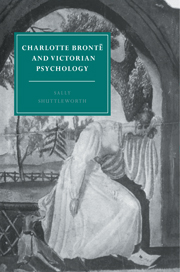Book contents
- Frontmatter
- Contents
- Acknowledgements
- Introduction
- PART ONE PSYCHOLOGICAL DISCOURSE IN THE VICTORIAN ERA
- PART TWO CHARLOTTE BRONTË'S FICTION
- 6 The early writings: penetrating power
- 7 The Professor: ‘the art of self-control’
- 8 Jane Eyre: ‘lurid hieroglyphics’
- 9 Shirley: bodies and markets
- 10 Villette: ‘the surveillance of a sleepless eye’
- Conclusion
- Notes
- Index
- CAMBRIDGE STUDIES IN NINETEENTH-CENTURY LITERATURE AND CULTURE
7 - The Professor: ‘the art of self-control’
Published online by Cambridge University Press: 06 November 2009
- Frontmatter
- Contents
- Acknowledgements
- Introduction
- PART ONE PSYCHOLOGICAL DISCOURSE IN THE VICTORIAN ERA
- PART TWO CHARLOTTE BRONTË'S FICTION
- 6 The early writings: penetrating power
- 7 The Professor: ‘the art of self-control’
- 8 Jane Eyre: ‘lurid hieroglyphics’
- 9 Shirley: bodies and markets
- 10 Villette: ‘the surveillance of a sleepless eye’
- Conclusion
- Notes
- Index
- CAMBRIDGE STUDIES IN NINETEENTH-CENTURY LITERATURE AND CULTURE
Summary
Charlotte Brontë's first major fictional work, The Professor, is centrally concerned, as its working title ‘The Master’ suggests, with questions of mastery and control. Social, economic, and psychological discourses of regulation and control furnish the discursive framework for this quintessential Victorian tale of social success. Our hero, William Crimsworth, offers a self-justificatory narrative of his rise from the position of penniless outcast to that of country gentleman with independent means. The trajectory of the plot, and the autobiographical form, anticipate Brontë's subsequent novel, Jane Eyre. The difference in gender of the protagonists is crucial, however: whereas Jane Eyre's social marginality duplicates and intensifies her gender position, there is, for Crimsworth, an acute disjunction between the two. His social powerlessness, by robbing him of the essential attributes of the Victorian male's gender identity – mastery and control – effectively feminizes him.
Crimsworth's tale of class mobility is informed throughout by gender anxiety and ambivalences. Problems of interpretation are intensified for the reader by awareness of the division between the male speaking voice who claims interpretative authority, and the shadowy female author who controls and exposes him. In a further interpretative twist, Crimsworth's autobiography is framed by another level of autobiography: material from Brontë's own life is assimilated across the gender and power divide, informing the representation of both master and pupil, William Crimsworth and his subsequent bride, Frances Henri.
- Type
- Chapter
- Information
- Charlotte Brontë and Victorian Psychology , pp. 124 - 147Publisher: Cambridge University PressPrint publication year: 1996



